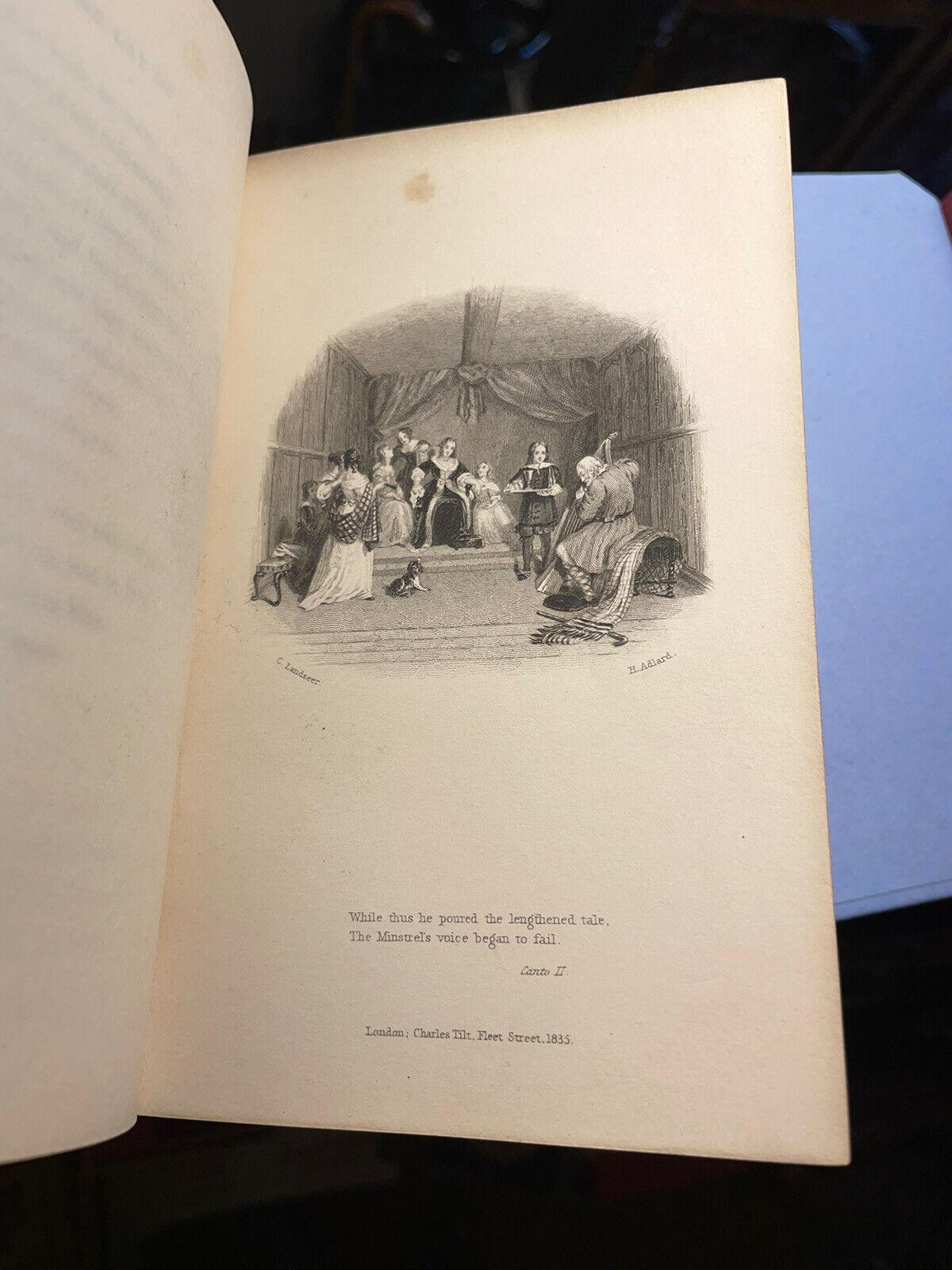1
/
of
11
The Gently Mad Book Shop
1835 THE LAY OF THE LAST MINSTREL Sir Walter Scott STEEL ENGRAVINGS Leather Gilt
1835 THE LAY OF THE LAST MINSTREL Sir Walter Scott STEEL ENGRAVINGS Leather Gilt
Regular price
£65.00 GBP
Regular price
Sale price
£65.00 GBP
Unit price
/
per
Tax included.
Couldn't load pickup availability
THE LAY OF THE LAST MINSTREL
By Sir Walter Scott
Published by Charles Tilt, London, 1835. Full leather with gilt, 8vo, gilt to all page edges, gilt to leather turn-ins, 303 pages, illustrated with fine steel engravings protected by plain tissue guards. Illustrated title page as well as printed title page.
CONDITION
In very good condition. The leather binding is in very good condition. Inner and outer joints sound. Inscription to front endpaper. Pages in good clean condition throughout. All engravings in good order and with no staining or foxing. Overall a very good early illustrated edition.
The Lay of the Last Minstrel (1805) is a narrative poem in six cantos with copious antiquarian notes by Walter Scott. Set in the Scottish Borders in the mid-16th century, it is represented within the work as being sung by a minstrel late in the 1600s.
Towards the end of 1802 Scott planned to include a long original poem of his own in the second edition of his edited collection Minstrelsy of the Scottish Border: it would be 'a sort of Romance of Border Chivalry & inchantment'. He owed the distinctive irregular accentual four-beat metre to Coleridge's Christabel, which he had heard recited by John Stoddart (it was not to be published until 1816). Scott tells how he showed the opening stanzas to his friends William Erskine and George Cranstoun, and believing that they had not approved, destroyed the manuscript. Some time later one of the friends indicated that they had been puzzled rather than disapproving and Scott proceeded, introducing the figure of the minstrel as intermediary between the period of the action and the present. The first canto was written while Scott was recovering from being kicked by a horse during a practice charge on Portobello sands. The figure of Gilpin Horner was included at the suggestion of the Countess of Dalkeith, though it is not certain at what stage. The third canto at least was finished by July 1803, and the whole poem was complete by August 1804.
By Sir Walter Scott
Published by Charles Tilt, London, 1835. Full leather with gilt, 8vo, gilt to all page edges, gilt to leather turn-ins, 303 pages, illustrated with fine steel engravings protected by plain tissue guards. Illustrated title page as well as printed title page.
CONDITION
In very good condition. The leather binding is in very good condition. Inner and outer joints sound. Inscription to front endpaper. Pages in good clean condition throughout. All engravings in good order and with no staining or foxing. Overall a very good early illustrated edition.
The Lay of the Last Minstrel (1805) is a narrative poem in six cantos with copious antiquarian notes by Walter Scott. Set in the Scottish Borders in the mid-16th century, it is represented within the work as being sung by a minstrel late in the 1600s.
Towards the end of 1802 Scott planned to include a long original poem of his own in the second edition of his edited collection Minstrelsy of the Scottish Border: it would be 'a sort of Romance of Border Chivalry & inchantment'. He owed the distinctive irregular accentual four-beat metre to Coleridge's Christabel, which he had heard recited by John Stoddart (it was not to be published until 1816). Scott tells how he showed the opening stanzas to his friends William Erskine and George Cranstoun, and believing that they had not approved, destroyed the manuscript. Some time later one of the friends indicated that they had been puzzled rather than disapproving and Scott proceeded, introducing the figure of the minstrel as intermediary between the period of the action and the present. The first canto was written while Scott was recovering from being kicked by a horse during a practice charge on Portobello sands. The figure of Gilpin Horner was included at the suggestion of the Countess of Dalkeith, though it is not certain at what stage. The third canto at least was finished by July 1803, and the whole poem was complete by August 1804.
(Loc: Shop; Top of Stairs; High shelf )
Share with someone






















